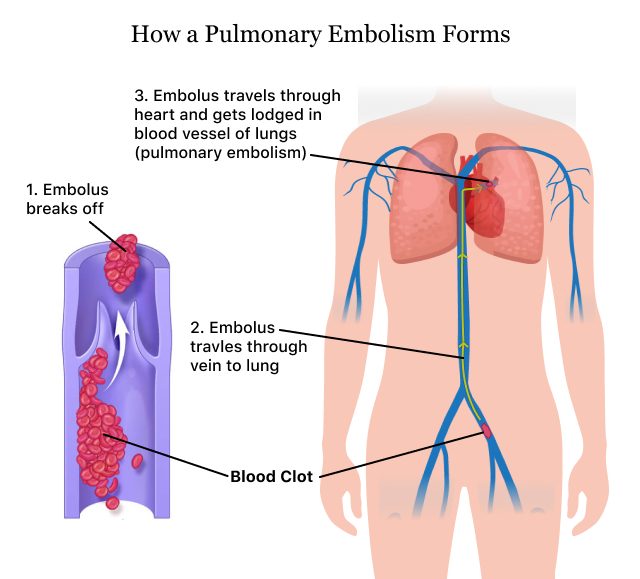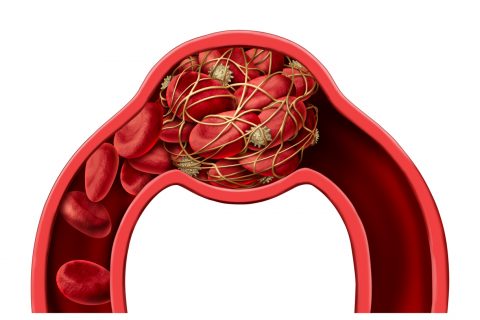Pulmonary Embolism
A pulmonary embolism, known as PE, is a blood clot in the lung that occurs when a clot travels from another part of the body — usually the legs — and blocks blood vessels in the lung. PEs are serious and can cause heart damage and death. Symptoms include shortness of breath and chest pain.
A thrombus is a clot that develops in a vein and doesn’t move. Once the clot dislodges and travels in the blood stream, it’s called an embolus. Most of the time, a pulmonary embolism starts as a deep vein thrombosis, also called a DVT, which is a clot that develops in the deep veins of the lower body — usually the pelvis, thighs and lower legs.
Once a DVT travels to the lungs, it’s called a pulmonary embolus. This type of clot blocks blood flow to the lungs and prevents the exchange of oxygen and carbon dioxide.
While researchers aren’t sure of the exact number of people who have pulmonary embolisms, they estimate the incidence is about 60 to 70 in 100,000, according to an article published in Experimental & Clinical Cardiology by Dr. Jan Belohlavek and colleagues.
Other studies estimate that more than 1 million Americans have a PE each year, and 100,000 to 200,000 of those cases are fatal, according to the American Thoracic Society.
Complications of pulmonary embolisms include lung damage, low blood oxygen level that can lead to organ damage and death.

Signs and Symptoms
Half of the people with a pulmonary embolism have no symptoms, according to the U.S. National Library of Medicine. Prevention of PE is important because for about 25 percent of people who have a PE, sudden death is the first symptom, according to the Centers for Disease Control and Prevention.
Symptoms of PE may be more or less severe depending on the person’s overall health and the extent of the blockage. For example, people with poor cardiovascular health or diseases such as chronic obstructive pulmonary disease, also called COPD, or coronary artery disease may have more severe symptoms.
For some people, the only symptom may be shortness of breath with rapid breathing and feelings of anxiety or restlessness. This may be accompanied by chest pain and rapid, irregular heartbeat.
If the clot is very large, the first symptoms are light-headedness or loss of consciousness. A sudden loss of consciousness may cause body shakes similar to seizures and low blood pressure, which could lead to sudden death.
Confusion and mental deterioration because of lack of oxygen are early symptoms that are more common in older people.
In data from the Prospective Investigation of Pulmonary Embolism Diagnosis II (PIOPED II) trial presented by Abigail K. Tarbox and Mamta Swaroop in International Journal of Critical Illness and Injury Science, the most common symptoms were shortness of breath within seconds of PE onset, chest pain, thigh or calf pain, thigh or calf swelling and cough.
- Chest pain that is worse with breathing
- Coughing or coughing up blood
- Dizziness, lightheadedness or fainting
- Irregular heartbeat
- Low blood pressure
- Racing heartbeat or palpitations
- Restlessness and anxiety
- Shortness of breath that comes on suddenly
- Sweating
In addition to symptoms of PE, some people may have symptoms of DVT, including pain in one or both legs, swelling, soreness or tenderness and redness, or discolored skin in the affected area.
Causes and Risk Factors
The most common cause of pulmonary embolisms is DVT, almost all of the clots start in the veins of the leg. But PEs can also develop from clots that form in the arms or pelvis.
- Amniotic fluid
- Clots on an indwelling intravenous catheter
- Fat released into the bloodstream after surgery, bone fractures, severe burns or other trauma
- Infectious material that forms small masses
- Rapidly growing cancer cells that form tumors
- Substances or air bubbles that enter the blood from surgery, trauma or other medical procedures
- Upper body DVT
Sources: Stanford Health Care and Cedars-Sinai
Risk Factors
Some people are at greater risk for PE. Some risk factors can be controlled, such as smoking or obesity. But others such as family history and age can’t be controlled.
- Genetic conditions that increase blood clot risk
- Family history
- Orthopedic surgery such as knee or hip replacement surgery
- Leg injuries
- Having limited mobility or paralysis
- Extended bed confinement
- Traveling long distances by plane or other vehicle
- Having previous blood clots
- Older age
- Cancer and cancer treatments such as chemotherapy
- Having other medical conditions such as chronic obstructive pulmonary disease (COPD), congestive heart failure (CHF), high blood pressure, stroke and inflammatory bowel disease
- Pregnancy
- Being obese or overweight
- Varicose veins, enlarged veins in the legs
- Smoking cigarettes
Certain medications may increase the risk of developing blood clots in the lungs. These include certain types of hormonal birth control such as Yaz (drospirenone) or NuvaRing, estrogen replacement therapy, testosterone replacement therapy or Xeljanz (tofacitinib).
For example, in July 2019, the U.S. Food and Drug Administration approved new warnings for Xeljanz for an increased risk of blood clots and death with the 10 mg twice-daily dose of tofacitinib used for ulcerative colitis patients.
Always tell your health care provider about all medication you are taking, especially if you are already at increased risk for PE.
How Is a Blood Clot in the Lung Diagnosed?
Pulmonary embolism can be difficult to diagnose because its symptoms mimic those of other health problems. Because less than half of patients who die from the condition were diagnosed before death, PE has earned the reputation of being a “silent killer,” according to the American Thoracic Society.
Tests
Health care providers will take a patient’s full medical history and perform a physical exam. Although there are several possible tests, most of them vary on accuracy for diagnosing PE. The most common tests are blood tests, CT scan, ultrasound and echocardiogram, according to the American Thoracic Society.
It may take more than one of these tests to diagnose PE.
Blood Tests
Health care providers use blood tests to check the blood’s clotting status and arterial gas levels. Abnormal arterial gas levels can indicate lack of oxygen and respiratory impairment. Blood tests are also used to check for genetic disorder that may be causing abnormal clotting.
CT scan
A CT scan uses a computer and X-rays to make detailed images of the body. A CT scan with contrast dye injected into the blood stream allows doctors to see the blood vessels in the lungs. This is the most common test for PE. But some people can’t undergo CT because of the contrast dye and radiation.
Duplex Ultrasound
A type of vascular ultrasound, a duplex ultrasound uses high-frequency sound waves to assess blood flow and the blood vessels in the legs. Most pulmonary embolisms begin as clots in the legs.
Echocardiogram
An echocardiogram is a type of ultrasound. Health care professionals often perform an echocardiogram of the heart to assess the severity of PE pressures and heart function.
PERC Rule for PE
Health care professionals may use the Pulmonary Embolism Rule-Out Criteria, or PERC, rule to see if someone needs to be tested for PE. According to the PERC rule, if a patient meets all eight criteria, they don’t need to be tested.
- Age less than 50 years
- Heart rate less than 100 beats/minute
- No exogenous estrogen use
- No hemoptysis (coughing up blood)
- No prior PE or deep venous thrombosis
- No recent trauma or surgery
- No unilateral leg swelling
- Oxygen saturation greater than 94 percent
Treating PE
People who require treatment for PE will usually have to be in the hospital so they can be monitored. The severity of the clot determines the course and length of treatment.
Treatment options may include anticoagulant medications, thrombolytic therapy and compression stockings. Sometimes a doctor will recommend surgery or interventional procedures to improve blood flow and reduce the risk of blood clots in the future.
Anticoagulant Medications
In most cases, treatment consists of anticoagulants, also called blood thinners. These help to prevent and break up smaller clots.
Heparin and warfarin, two medications that have been on the market for a while, require blood tests to get the exact dose for the individual. People taking these medications must also get routine blood tests to make sure the dose is working or isn’t too high.
Newer blood thinners such as Pradaxa (dabigatran), Xarelto (rivaroxaban) and Eliquis (apixaban) come in once-a-day doses and don’t require blood tests.
The most serious side effect of blood thinners is uncontrolled bleeding, but most blood thinners on the market now have antidotes to reverse anticoagulation for life-threatening bleeds.
In emergency cases, some patients may take thrombolytic medications, also called “clot busters.” Health care providers deliver these medications directly to the clot through a catheter, and the medication dissolves the clot.
Compression Stockings
Compression stockings, or support hose, are usually knee-high length and compress your legs to prevent the pooling of blood. They also aid blood flow in the legs. A health care provider will instruct the patient on how to use them and for how long.
Procedures
Sometimes medications and support stocking aren’t enough. If a pulmonary embolism is life-threatening, a doctor may recommend surgery to remove the clot.
Another type of invasive treatment involves the use of a small, metal cage-like device called an intravenous vena cava filter, or IVC filter. Surgeons implant the IVC filter into the vena cava, the body’s largest vein, to act like a trap for blood clots. The IVC filter catches clots as they travel through the blood stream and prevents them from reaching the lungs.
The Pulmonary Embolus Severity Index (PESI)
The PESI is a calculation tool that doctors can use to determine the severity of PE. People with the following criteria score higher on the PESI and are at greater risk of death following PE.
- Blood oxygen saturation levels less than 90 percent
- Disorientation, coma, stupor or other altered mental status
- Heart rate 110 or higher
- History of heart failure
- History of lung disease
- Male gender
- Older Age
- Respiratory rate 30 or higher
- Systolic Blood Pressure less than 100 mmHg
- Temperature less than 96.8 degrees
Tips for Preventing Clots
The best treatment for pulmonary embolisms is prevention, especially for people who have a higher risk for DVT or PE. Many prevention tips are simple lifestyle changes. A health care provider may also recommend medications to manage health conditions that could lead to PE.
- Ask your doctor if any of the medications you take could increase you risk of PE.
- Avoid dehydration by drinking plenty of fluids, but avoid caffeine and alcohol.
- Get regular exercise. If you cannot exercise because you have a health condition, need bed rest or are traveling, make sure to move your feet, legs and arms for a few minutes each hour. Compression stockings can also help blood flow.
- If you are obese or overweight, get to a health body weight.
- If you smoke, quit.
- Take medications as prescribed by your doctor.
- Try not to cross your legs.
- Twice a day take 30 minutes to elevate your feet.
- Wear loose-fitting clothing.
Calling this number connects you with a Drugwatch.com representative. We will direct you to one of our trusted legal partners for a free case review.
Drugwatch.com's trusted legal partners support the organization's mission to keep people safe from dangerous drugs and medical devices. For more information, visit our partners page.


